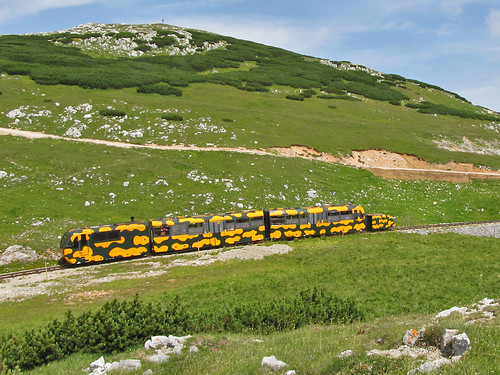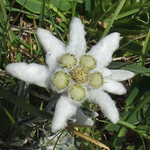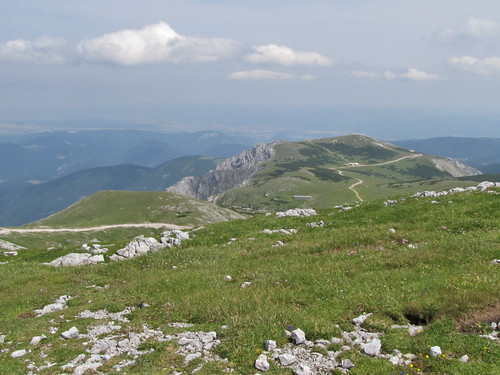 |
| Salamanderzug near the top station. |
It's been a few years since I've been anywhere in the Alps in Summer, and in the meantime I've improved my botanical knowledge enormously. So high on my list of things to do was to look at alpine flowers properly for the first time. This is pretty much incompatible with serious hiking: botanising takes time, it's eminently possible to travel at about 100 metres/hour.
I therefore wanted somewhere close to Vienna with mountains high enough to have an alpine flora still in flower, and some kind of mechanical uplift. The obvious choice was the Wiener Hausgebirge, groups of limestone peaks reaching over 2000 m about 50 km SW of Vienna I've known about this area for a number of years: when my brother lived in the Viennese suburb of Meidling, I went skiing on a local hill, the Zauberberg at Semmering. At that time I noted the peaks of the Rax-Schneeberg area from the wonderful switchback railway over the Semmering pass.
The village of Puchberg-am-Schneeberg is still a popular day-trip destination from Vienna, but in the past was a small spa resort. There's one large hotel and a smattering of smaller places. I stayed in the Bruckerhof which turned out to be a nice place in a good location at a great price. It is only a couple of hundred metres from the station, and set back from the main road.
Puchberg was pretty quiet in the evening. I had the impression most visitors were, like the guests in my hotel, of a certain age. I was troubled that I'd have difficulty finding a place to eat, as most people seemed to have dined by half-past six. However, the Schwarzer Adler not only did food, put had a proper pub-like atmosphere down to guys playing cards at the Stammtisch.
With an altitude range of around 1500 metres from the village at just under 600 m to the summit of the Klosterwappen on the Schneeberg at 2076m there was a huge range of interesting habitats to explore. The only downside was that most of the lowland hay meadows had just been cut: so I missed out on some obvious places to botanise. On my first afternoon I wandered (very slowly) up the zigzag track through pine woods to the little peak of the Himberg.
 |
| Edelweiss (Leopondtidum nivale) |
What has this to do with maps? Well the whole area around Puchberg and the Schneeberg itself are great exemplars of the sort of habitats (strictly biotopes) of the kind I would like to map.
Walking up the path to Himberg, I started in woodland dominated by Austrian Pine (Pinus nigra ssp., Schwarzkiefer), but on the northern side of the hill, this graded in Spruce Picea alba woodland (Tannenwald). Further along there were areas of Beech woodland (Buchenwälder). These are very noticeable: the pine wood has much more light than the spruce wood, and very different plants in the under-storey. Beech woods are different again. The plateau of the Schneeberg was a mosaic of grazed areas with a wide range of herbs and sub-shrubs (Mountain Willows, Mountain Avens, Dryas octopetala; Rose), and extensive areas of Pinus mugo scrub. These can be seen behind the train in the picture at the head of this entry. On the steeper sides of the Schneeberg, flushed areas within the Pinus mugo scrub had different plants again, such as Water Avens and . These were frequented by Fritillary butterflies. The scrub grades into forest, but at around 1000 metres there were many hay meadows, again with a different flora: it was around that I saw Martagon Lily.
The Schneeberg is also an important water catchment area for Vienna. There are a number of limestone sink holes in the summit area from which the general public is excluded to avoid polluting the supply. Again this is a feature which is still difficult to map in OSM.
 |
| From near Klosterwappen looking across Ochsenboden |
The official map made by BEV doesn't do a bad job of showing some of this information, despite really being a 1:50k topomap. It has a lot of toponymic detail, maps the Pinus mugo scrub, shows a lot of detail of the NE-face. It doesn't attempt to separate out the different forest biotopes: this is something I think is an eminently practical thing to do in OSM. The Schneeberg area is a great place to start.
Another aspect of the Schneeberg is that the NE face offers fantastic opportunities for spring skiing. I discussed this briefly with Felix Hartmann (extremecarver) after SotM-EU, who knows this area well. These are extremely well known, but not mapped on OSM. We don't have a sensible way to map this kind of ski route, nor for labelling features such as chutes, couloirs and gullies.
Notes
GPX traces : http://www.openstreetmap.org/user/SK53/traces/1062809 , http://www.openstreetmap.org/user/SK53/traces/1062810
List of plants seen: Pinus mugo, Pinus nigra, Picea abies (Fichte, Norway Spruce), Fraxinus excelsior Ash, Salix fragilis (Crack Willow)5, Beech, Pedunculate Oak, Purging Buckthorn, European Spindle, Viburnum latana (Wayfaring Tree)10, (Wild Marjoram), Adenostyles alliariae (), Leontopontidon niavle (Edelweiss), Dwarf Saussurea, Brown Knapweed)15, Perennial Cornflower, Hemp Agrimony, Bath Asparagus, Allium (), Alpine Bistort)20, Alpine Sowthistle, Large-leaved Lime, Yellow Melancholy Thistle, Hogweed)25, Wall Germander, Mountain Germander, Betony, Cyclamen purpurescens (Sowbread), Ranunculus platanifolius ()30, (Globeflower), (Water Avens), Dryas octopetala (Mountain Avens), (Alpine Avens), (Himalayan Balsam)35, (Small Balsam), Meadowsweet, Nottingham Catchfly, Alpine Pink, Alpine Catchfly)40, Kidney Vetch, Alchemilla sp., Martagon Lily, Bladder Campion, Large Yellow Foxglove)45, Wolfsbane, Great Marsh Thistle, Wild Pear, Hawthorn, Milk Vetch)50, Common Rockrose, False White Helleborine, Mountain Sanicle, Sickle Hare's Ear, androsace sp. ()55, Viper's Bugloss, Alpine Forget-me-not, Jupiter's Distaff, Dark Mullein, Eyebright)60, Lousewort, Deadly Nightshade, Rampion, Bellflower, Bellflower)65, Leopardsbane, Woolly Thistle, Jurinea, Golden Hawksbeard, Orchid 1)70, Orchid 2, Orchid 3, Bearded Bellflower, Large Self-Heal74, Inula spp. ()75 , Dogwood, Acer pseudoplatanus (Sycamore, Bergahorn), (Cowwheat), Vincetoxicum hirundinaria (Vincetoxicum, Schwalbenwurz), (Columbine)80, Sorbus sp. (), Elder, Greater Celandine, Horse Chestnut, Goat Willow, Wormwood, Sainfoin, Arctium tomentosum, Nettle, Blackthorn, Hornbeam, Black Bryony, Lady's Bedstraw, Greater Plantain
More photos: http://www.flickr.com/photos/mausboam/6013969441/
No comments:
Post a Comment
Sorry, as Google seem unable to filter obvious spam I now have to moderate comments. Please be patient.